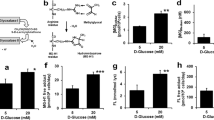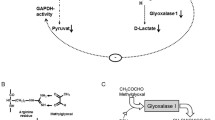Abstract
Glycophosphatidylinositol (GPI)-anchored proteins are one of the membrane-bound proteins that have diverse functions. There have been some reports that their expression or activities are altered in diabetes. Many proteins, including GPI-anchored proteins, lose their biological function secondary to carbonylation in diabetes. Carbonylation causes oxidative damage of numerous proteins in the human body. Diabetic complications are related to carbonyl adducts in vascular tissue. Therefore, we examined whether carbonyl compounds associated with diabetes affect the expression of GPI-related genes in human umbilical vein endothelial cells (HUVECs). Among the more than 150 GPI anchor-related genes investigated, 54 genes were up-regulated by more than 2-fold, while 31 genes were down-regulated with altered expression levels of 2-fold in acrolein (ACR)-treated cells. The majority of the genes changed by ACR involved GPI anchor biosynthesis. Crotonaldehyde and methylglyoxal altered a few genes encoding GPI-anchored proteins. According to their functional characteristics, genes were classified into the Gene Ontology functional categories. We also identified the distribution of functional groups of GPI anchor-related genes in HUVECs. In conclusion, our data suggest that these reactive carbonyl compounds modulate GPI anchor-related gene expression, which may have a role in diabetic vasculopathy.
Similar content being viewed by others
References
Orlean, P. & Menon, A.K. GPI anchoring of protein in yeast and mammalian cells, or: how we learned to stop worrying and love glycophospholipids. J. Lipid Res. 48, 993–1011 (2007).
Lisanti, M.P., Rodriguez-Boulan, E. & Saltiel, A.R. Emerging functional roles for the glycosyl-phosphatidylinositol membrane protein anchor. J. Membr. Biol. 117, 1–10 (1990).
Hazenbos, W.L., Wu, P., Eastham-Anderson, J., Kinoshita, T. & Brown, E.J. Impaired FcepsilonRI stability, signaling, and effector functions in murine mast cells lacking glycosylphosphatidylinositol-anchored proteins. Blood 118, 4377–4383 (2011).
Murata, D. et al. GPI-anchor synthesis is indispensable for the germline development of the nematode Caenorhabditis elegans. Mol. Biol. Cell 23, 982–995 (2012).
Leidich, S.D., Drapp, D.A. & Orlean, P. A conditionally lethal yeast mutant blocked at the first step in glycosyl phosphatidylinositol anchor synthesis. J. Biol. Chem. 269, 10193–10196 (1994).
Kawagoe, K. et al. Glycosylphosphatidylinositol-anchordeficient mice: implications for clonal dominance of mutant cells in paroxysmal nocturnal hemoglobinuria. Blood 87, 3600–3606 (1996).
Nozaki, M. et al. Developmental abnormalities of glycosylphosphatidylinositolanchor-deficient embryos revealed by Cre/loxP system. Lab. Invest. 79, 293–299 (1999).
Nagamune, K. et al. Critical roles of glycosylphosphatidylinositol for Trypanosoma brucei. Proc. Natl. Acad. Sci. USA 97, 10336–10341 (2000).
Gillmor, C.S. et al. Glycosylphosphatidylinositol-anchored proteins are required for cell wall synthesis and morphogenesis in Arabidopsis. Plant Cell 17, 1128–1140 (2005).
Ueda, Y. et al. PGAP1 knock-out mice show otocephaly and male infertility. J. Bio. Chem. 282, 30373–30380 (2007).
Karnieli, E., Armoni, M., Cohen, P., Kanter, Y. & Rafaeloff, R. Reversal of insulin resistance in diabetic rat adipocytes by insulin therapy. Restoration of pool of glucose transporters and enhancement of glucosetransport activity. Diabetes 36, 925–931 (1987).
Skillen, A.W., Hawthorne, G.C. & Turner, G.A. Serum alkaline phosphatase in rats with streptozotocin-induced diabetes. Horm. Metab. Res. 19, 505–506 (1987).
Acosta, J. et al. Molecular basis for a link between complement and the vascular complications of diabetes. Proc. Natl. Acad. Sci. USA 97, 5450–5455 (2000).
Vlassara, H. Recent progress in advanced glycation end products and diabetic complications. Diabetes 46, S19-25 (1997).
Hotta, N. New approaches for treatment in diabetes: aldose reductase inhibitors. Biomed. Pharmacother. 49, 232–243 (1995).
Lapolla, A. & Fedele, D. [Oxidative stress and diabetes: role in the development of chronic complications]. Minerva Endocrinol. 18, 99–108 (1993).
Kennedy, A.L. & Lyons, T.J. Glycation, oxidation, and lipoxidation in the development of diabetic complications. Metabolism 46, 14–21 (1997).
Witztum, J.L. Role of modified lipoproteins in diabetic macroangiopathy. Diabetes 46, S112–114 (1997).
Ishii, H., Koya, D. & King, G.L. Protein kinase C activation and its role in the development of vascular complications in diabetes mellitus. J. Mol. Med. (Berl) 76, 21–31 (1998).
Chiarelli, F., Santilli, F. & Mohn, A. Role of growth factors in the development of diabetic complications. Horm. Res. 53, 53–67 (2000).
Thomson, S.E., McLennan, S.V. & Twigg, S.M. Growth factors in diabetic complications. Expert Rev. Clin. Immunol. 2, 403–418 (2006).
Baynes, J.W. Role of oxidative stress in development of complications in diabetes. Diabetes 40, 405–412 (1991).
McLellan, A.C., Thornalley, P.J., Benn, J. & Sonksen, P.H. Glyoxalase system in clinical diabetes mellitus and correlation with diabetic complications. Clin. Sci. (Lond) 87, 21–29 (1994).
Berlanga, J. et al. Methylglyoxal administration induces diabetes-like microvascular changes and perturbs the healing process of cutaneous wounds. Clin. Sci. 109, 83–95 (2005).
Ramasamy, R., Yan, S.F. & Schmidt, A.M. Methylglyoxal comes of AGE. Cell 124, 258–260 (2006).
Minko, I.G. et al. Chemistry and biology of DNA containing 1,N(2)-deoxyguanosine adducts of the alpha, beta-unsaturated aldehydes acrolein, crotonaldehyde, and 4-hydroxynonenal. Chem. Res. Toxicol. 22, 759–778 (2009).
Medina-Navarro, R., Nieto-Aguilar, R. & Alvares-Aguilar, C. Protein conjugated with aldehydes derived from lipid peroxidation as an independent parameter of the carbonyl stress in the kidney damage. Lipids in Health and Disease 10, 1–7 (2011).
Suzuki, D. & Miyata, T. Carbonyl stress in the pathogenesis of diabetic nephropathy. Intern. Med. 38, 309–314 (1999).
Lee, S.E. et al. Differentially-expressed genes related to atherosclerosis in acrolein-stimulated human umbilical vein endothelial cells. BioChip J. 4, 264–271 (2010).
Lee, S.E. et al. Methylglyoxal-mediated alteration of gene expression in human endothelial cells. BioChip J. 5, 220–228 (2011).
Imai, T. et al. DNA microarray analysis of the epithelialmesenchymal transition of mesothelial cells in a rat model of peritoneal dialysis. Adv. Perit. Dial. 27, 11–15 (2011).
Jeong, S.I. et al. Genome-wide analysis of gene expression by crotonaldehyde in human umbilical vein endothelial cells. Mol. Cell. Toxicol. 7, 127–134 (2011).
Trevino, V., Falciani, F. & Barrera-Saldana, H.A. DNA microarrays: a powerful genomic tool for biomedical and clinical research. Mol. Med. 13, 527–541 (2007).
Archacki, S.R. & Wang, Q.K. Microarray analysis of cardiovascular diseases. Methods Mol. Med. 129, 1–13 (2006).
Hiltunen, M.O. et al. Changes in gene expression in atherosclerotic plaques analyzed using DNA array. Atherosclerosis 165, 23–32 (2002).
Lee, N.J., Lee, S.E., Lee, S.H., Ryu, D.S. & Park, Y.S. Acrolein induces adaptive response through upregulate of HO-1 via activation of Nrf2 in RAW 264.7 macrophage. Mol. Cell. Toxicol. 5, 230–236 (2009).
Thompson, C.A. & Burcham, P.C. Genome-wide transcriptional responses to acrolein. Chem. Res. Toxicol. 21, 2245–2256 (2008).
Kutzman, R.S., Wehner, R.W. & Haber, S.B. The impact of inhaled acrolein on hypertension-sensitive and resistant rats. J. Environ. Pathol. Toxicol. Oncol. 6, 97–108 (1986).
Srivastava, S. et al. Oral exposure to acrolein exacerbates atherosclerosis in apoE-null mice. Atherosclerosis 215, 301–308 (2011).
Orlean, P. & Menon, A.K. Thematic review series: lipid posttranslational modifications. GPI anchoring of protein in yeast and mammalian cells, or: how we learned to stop worrying and love glycophospholipids. J. Lipid Res. 48, 993–1011 (2007).
Yang, H. et al. Up-regulation of heme oxygenase-1 by Korean red ginseng water extract as a cytoprotective effect in human endothelial cells. J. Ginseng Res. 35, 352–359 (2011).
Park, Y.S. et al. Acrolein induces cyclooxygenase-2 and prostaglandin production in human umbilical vein endothelial cells: roles of p38 MAP kinase. Arterioscler. Thromb. Vasc. Biol. 27, 1319–1325 (2007).
Author information
Authors and Affiliations
Corresponding author
Rights and permissions
About this article
Cite this article
Yang, H., Lee, S.E., Jeong, S.I. et al. Differentially-expressed genes associated with glycophosphatidylinositol (GPI)-anchored proteins by diabetes-related toxic substances in human endothelial cells. BioChip J 6, 262–270 (2012). https://doi.org/10.1007/s13206-012-6309-y
Received:
Accepted:
Published:
Issue Date:
DOI: https://doi.org/10.1007/s13206-012-6309-y




